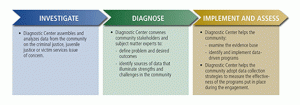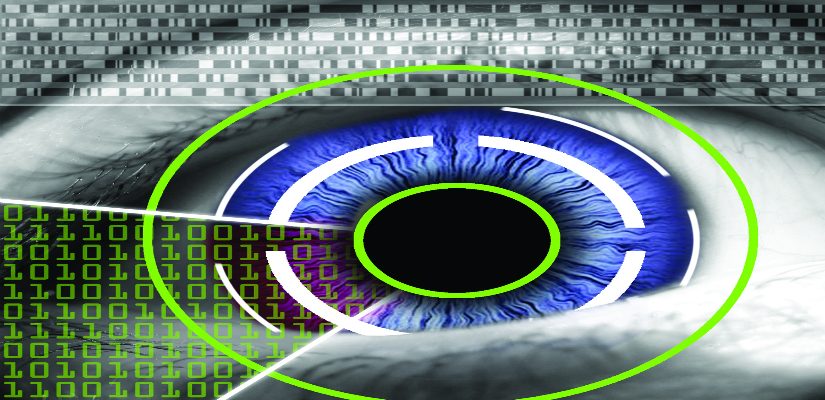Effectively addressing human trafficking can pose a significant challenge to communities without established practices for identifying and protecting human trafficking victims and investigating and prosecuting cases against traffickers.
The U.S. Department of Justice (DOJ), Office of Justice Programs launched the Diagnostic Center in 2012. The center is a technical assistance resource for law enforcement executives and policy makers who want to use data-driven strategies to combat crime and improve public safety. The purpose of the Diagnostic Center is to build local capacity to incorporate data and research into public safety and criminal justice practices and policies to ensure resources are invested wisely, assets are used where they are needed most, and communities reap improved public safety outcomes.
 The city of Albert Lea, Minnesota, is a current client engaged with the Diagnostic Center to assess the impact of human trafficking, particularly sex trafficking, in the community and identify best practices to address these crimes. With a population just under 20,000 and a geographical area less than 15 square miles in south-central Minnesota, Albert Lea is similar to many small towns across the United States. A detective working on an assault case involving two exotic dancers believed both the victim and the perpetrator might be victims of human trafficking. Seeking to proactively address the potential trafficking issue, the Albert Lea Police Department asked the Diagnostic Center for help.
The city of Albert Lea, Minnesota, is a current client engaged with the Diagnostic Center to assess the impact of human trafficking, particularly sex trafficking, in the community and identify best practices to address these crimes. With a population just under 20,000 and a geographical area less than 15 square miles in south-central Minnesota, Albert Lea is similar to many small towns across the United States. A detective working on an assault case involving two exotic dancers believed both the victim and the perpetrator might be victims of human trafficking. Seeking to proactively address the potential trafficking issue, the Albert Lea Police Department asked the Diagnostic Center for help.
The city’s request to the Diagnostic Center focused on (1) identifying the extent of human trafficking for sexual purposes in the community by developing strategies for data collection and analysis; (2) improving law enforcement training to respond to human trafficking; and (3) raising community awareness to combat the problem. The Diagnostic Center also helps Albert Lea identify resources to serve the needs of human trafficking victims.
Using the Diagnostic Center model above, which starts and finishes with an assessment of local data, the center’s specialists analyze existing law enforcement data such as locations of offenses; arrest data for sex trafficking and prostitution; arrest data for those soliciting sex, data on juvenile offenses such as runaways; case review of charges of child abuse and drug trafficking, which the research shows may be tied to human trafficking; referrals for prosecution for any of these offenses; convictions; and victim and offender demographic information. These data are supplemented with interviews with law enforcement officers and professionals in other criminal justice agencies, victim service providers, community leaders, health care providers, and school administrators. Other key stakeholders, including Albert Lea Citizens Against Human Trafficking Task Force, the Minnesota Human Trafficking Task Force, and the United States Attorney’s Office are also involved—federal prosecutors often have experience prosecuting trafficking cases that can help formulate local responses.
The Diagnostic Center will use the data collected to help Albert Lea define the scope of the problem and customize recommendations to address Albert Lea’s goals to improve public safety. These recommendations will identify data-driven programs and practices that can be strategically implemented to produce measurable, positive results, and Albert Lea policy makers will select which strategies to pursue. The Diagnostic Center will support the implementation of the selected strategies with training and technical assistance and other resources and will help the community collect and analyze outcome data to measure progress in curtailing human trafficking.
| “Albert Lea PD welcomes the assistance of the Diagnostic Center in applying data-driven solutions within our community. Working with the Diagnostic Center, our community plans to utilize the data to narrow in on the issue, implement proven solutions and ultimately make a tremendous impact for our citizens,”
— J.D. Carlson, Albert Lea Police Department, Deputy Director of Police. |
The Diagnostic Center model differs from traditional training and technical assistance models.
- It begins and ends with an assessment of local data to first define the scope of the problem and then demonstrate the effectiveness of the interventions.
- It increases the capacity of the client community to use data, not only in the current instance, but also in all future decision making.
- It leverages resources from across DOJ and other federal and private partners to target investments where communities need them the most.
There is no one-size-fits-all solution to human trafficking. The Diagnostic Center tailors its support to each community’s needs, using proven data-driven crime prevention solutions, along with advice from subject matter experts. In every instance, the Diagnostic Center encourages community leaders to involve a broad range of community stakeholders. From the initial engagement to implementation of evidence-based solutions to evaluation, collaboration is a key ingredient.
|
Hoping to improve its identification and response to human trafficking cases, the community of Manassas, Virginia, worked with the Diagnostic Center in 2013 to identify programs and initiatives aimed at preventing instances of human trafficking. The Diagnostic Center compiled a list of resources and services available to assist jurisdictions with the reporting and investigation of human trafficking cases. View the Diagnostic Center’s Executive Reference Guide: Human Trafficking. |
Since its launch in 2012, the Diagnostic Center has evaluated technical assistance requests from 58 communities, representing corrections, courts, law enforcement and crime prevention, tribal justice, victim advocacy, and youth advocacy. The Diagnostic Center has conducted over 400 interviews and 22 site visits with criminal justice agency stakeholders across 15 state, local, and tribal communities to implement research- or evidence-based interventions and solutions.
Like Albert Lea, communities across the United States can consult with the Diagnostic Center. If a community is experiencing a persistent criminal justice, juvenile justice, or victim services issue, please contact the Diagnostic Center to learn about its technical assistance services. The Diagnostic Center will discuss the scope of the issue and determine the level of support it may be able to provide. Call the Diagnostic Center at 885-657-0411 or email contact@OJPDiagnosticCenter.org.♦
Please cite as:
Katherine Darke Schmitt, “The Justice Department’s Diagnostic Center Provides Technical Assistance to Address Human Trafficking,” The Police Chief 81 (July 2014): web-only article.
| To view the bonus online article “Human Trafficking 101 for Law Enforcement,” please click here.To view the bonus online article “Human Trafficking Training and Resources,” please click here. |



